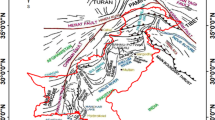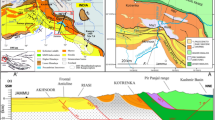Abstract
This paper presents a Bayesian methodology for updating the seismic hazard curves. The methodology is based on the comparison of predictive exceedance rates of a fixed acceleration level (given by the seismic hazard curves) and the observed exceedance rates in some selected sites. The application of the methodology needs, firstly, the definition of a prior probabilistic seismic hazard assessment based in a logic tree. Each main branch corresponds to a probabilistic model of calculus of seismic hazard. The method considers that, initially (or a priori), the weights of all branches of the logic tree are equivalent. Secondly, the method needs to compile the observations in the region. They are introduced in a database containing the recorded acceleration data (during the instrumental period). Nevertheless, the instrumental period in stable zones (as France) shows only very low acceleration levels recorded during a short observation period. Then, a method to enlarge the REX (number of observations) is presented taking into account the historical data and defining “synthetic” accelerations in the sites of observation. The synthetic REX allows to expand the period of observation and to increase the acceleration thresholds used in the Bayesian updating process. The application of the Bayesian approach leads to a new and more objective definition of the weights of each branch of the logic tree and, therefore, to new seismic hazard curves (mean and centiles). The Bayesian approach doesn’t change the probabilistic models (seismic hazard curves). It only modifies the weights of each branch of the logic tree.








Similar content being viewed by others
References
Akkar S, Bommer JJ (2010) Empirical equations for the prediction of pga, pgv and spectral accelerations in europe, the mediterranean region and the middle east. Seismol Res Lett 81(2):195–206
Atkinson GM, Boore DM (2011) Modifications to existing ground-motion prediction equations in light of new data. Bull Seismol Soc Am 101(3):1121–1135. doi:10.1785/0120100270
Atkinson G, Kaka S (2007) Relationships between felt intensity and instrumental ground motion in the Central United States and California. Bull Seismol Soc Am 97(2):497–510. doi:10.1785/0120060154
Berge-Thierry C, Griot-Pommera DA, Cotton F, Fukushima Y (2003) New empirical response spectral attenuation laws for moderate European earthquakes. J Earthquake Eng 7(2):193–222
Carbon D, Martin C, Secanell R (2007) Evaluation probabiliste de l’aléa sismique en intensité à l’échelle nationale. Lois d’atténuation en intensité, tests des modèles et confrontation au Rex. Rapport GEOTER—Ref n° GTR/EDF/0707-396
Carbon D, Drouet S, Gomes C, Leon A, Martin C, Secanell R (2012). Initial probabilistic seismic hazard model for France’s southeast 1/4. Inputs to sigma project for tests and improvements. Technical Report Ref: SIGMA-2012-D4-41, Seismic, 150 pages
Cauzzi C, Faccioli E (2008) Broadband (0.05 to 20 s) prediction of displacement response spectra based on worldwide digital records. J Seismolog 12(4):453–475
Decanini L, Gavarini C, Mollaioli F (1995) Proposta di definizione delle relazioni tra intensita’macrosismica e parametri de1 moto de1 suolo. In: Atti del 7′ Convegno Anidis 1, Siena, Italy 25–28 Sep 1995, pp. 63–72
Drouet S, Cotton F (2015) Regional stochastic GMPEs in low-seismicity areas: scaling and aleatory variability analysis—application to the French Alps. Bull Seismol Soc Am. doi:10.1785/0120140240
Faccioli E, Cauzzi C (2006) Macroseismic intensities for seismic scenarios estimated from instrumentally based correlations. In: Proceedings of first European conference on earthquake engineering and seismology, p 569
Gómez Capera AA, Albarello D, Gasperini P (2007) Aggiornamento relazioni fra l’intensità macrosismica e PGA. Progetto DPC-INGV S1, http://esse1.mi.ingv.it/d11.html
Humbert N, Viallet E (2008) A method for comparison of recent PSHA on the French territory with experimental feedback. In: Proceedings of the 14th world conference on earthquake engineering, Beijing, China, 12–17 Oct 2008
Martin Ch, Secanell R, Viallet E, Humbert N (2008) Consistency of PSHA models in acceleration and intensity by confrontation of predictive models to available observations in France. Working group on integrity of components and structures (IAGE) recent findings and developments in probabilistic seismic hazards analysis (PSHA) Methodologies and Applications, 7–9 Apr 2008, Lyon, France
Mezcua J, Ruedar J, Blanco RMG (2004) Re-evaluation of historic earthquakes in Spain. Seismol Res Lett 75:75–81
Mezcua J, Rueda J, García Blanco RM (2013) Observed and calculated intensities as a test of a probabilistic seismic-hazard analysis of Spain. Seismol Res Lett. doi:10.1785/0220130020
OECD (2015) In: Workshop on testing probabilistic seismic hazard analysis results and the benefits of Bayesian techniques, OECD/NEA/CSNI Wokshop, Pavia, Italy, 4–6 Feb 2015 (https://www.oecd-nea.org/nsd/docs/2015/csni-r2015-15.pdf)
Panza GF, Cazzaro R, Vaccari EF (1997) Correlation between macroseismic intensities and seismic ground motion parameters. Ann Geophys XL 5:1371–1382
Beauval C, Bard PY, Hainzl S, Gueguin Ph (2007) Aléa sismique probabiliste: les limites d’une comparaison entre estimations et observations. 7ème Colloque National AFPS 2007 – Ecole Centrale Paris
PS92 règles de construction parasismique (1995) AFNOR NF P 06-013. (https://www.icab.fr/guide/ps92/) Déc 1995
Secannel R, Martin CH (2014): Methodological exercise for testing a statistical approach to update a probabilistic seismic hazard assessment, Ref: SIGMA-2013-D4-139, web site in progress
Scherbaum F, Delavaud E, Riggelsen C (2009) Model selection in seismic hazard analysis: an information-theoretic perspective. Bull Seismol Soc Am 99(6):3234–3247
Selva JU, Sandri L (2013) Probabilistic Seismic hazard assessment: combining cornell-like approaches and data at sites through bayesian inference. Bull Seismol Soc Am 103(3):1709–1722103. doi:10.1785/0120120091
Viallet E, Humbert N, Mottier P (2017) Updating of a PSHA based on Bayesian inference with historical macroseismc intensities. In: 16th world conference on earthquake engineering, 16WCEE 2017, Santiago Chile, 9–13 Jan 2017
Woo G (1999) The mathematics of natural catastrophes. Published by Imperial College, London. ISBN 1-86094-182-6
Woo G, Aspinall WP (2015) Thirty-year Bayesian updating of PSHA for Hinkley Point NPP. In: CSNI workshop on testing PSHA results and benefit of bayesian techniques for seismic hazard assessment, Eucentre Foundation, Pavia, 4–6 Feb 2015
Zhao JX, Zhang J, Asano A, Ohno Y, Oouchi T, Takahashi T, Ogawa H, Irikura K, Thio HK, Somerville PG, Fukushima Y, Fukushima Y (2006) Attenuation relations of strong ground motion in japan using site classification based on predominant period. Bull Seismol Soc Am 96(3):898–913
Author information
Authors and Affiliations
Corresponding author
Rights and permissions
About this article
Cite this article
Secanell, R., Martin, C., Viallet, E. et al. A Bayesian methodology to update the probabilistic seismic hazard assessment. Bull Earthquake Eng 16, 2513–2527 (2018). https://doi.org/10.1007/s10518-017-0137-3
Received:
Accepted:
Published:
Issue Date:
DOI: https://doi.org/10.1007/s10518-017-0137-3




